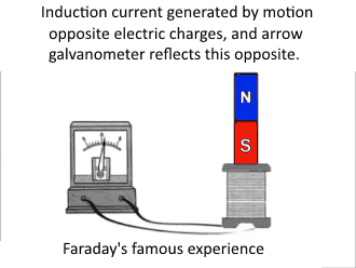
Proof of the existence of a positron current
No one doubts the existence of the electronic current, and there is no reason to prove it, although in the modern theory of electricity the AC theory, based on the assumption that electrons can run in one direction and then in the opposite direction, is clearly erroneous and requires a refutation.
To prove the existence of a positron current, it is enough to pass the current rectified by the semiconductor bridge through the frame of the magnetoelectric galvanometer in one direction and then in the opposite direction.
Forward positron current deflects the arrow toward the south pole of the magnet, and a reverse positron current deflects the arrow toward the north pole of the magnet.
If the electronic current rectified by the bridge with vacuum diodes is skipped in the same way as the positron current, then in this case, the forward electron current deflects the arrow toward the north pole of the magnet, and the reverse electron current deflects the arrow toward the south pole of the magnet.
These experiments prove that, in addition to the electron current, there is also a positron current.
Faraday in his famous experiment received an alternating current of electrons and positrons, where the galvanometer needle deflects alternately to the north pole of the magnet (electron current) and to the south pole of the magnet (positron current), and where the electron current cannot turn around and flow back, because only a positron current can flow.
Thus, the theory of alternating current in the modern theory of electricity is not true, like the whole theory of current, as the current of free electrons
The current we use is the current of electrons and positrons that travels around the conductors and live parts of electrical appliances.
Free electrons in metal conductors play the role of electrical resistance, “freezing” of which to atoms gives rise to superconductivity.
The conductivity current, the current we use, is the electron-positron current propagating around the conductors and current-carrying parts of electrical appliances.
Доказательство существования позитронного тока
В существовании электронного тока никто не сомневается, и доказывать незачем, хотя в современной теории электричества теория переменного тока, построенная на предположении, что электроны могут бежать в одном направлении, а затем в противоположном направлении, явно ошибочна, и требует опровержения.
Для доказательства существования позитронного тока достаточно пропустить, выпрямленный полупроводниковым мостом ток через рамку магнитоэлектрического гальванометра, в одном направлении, а затем в обратном направлении.
Прямой позитронный ток отклоняет стрелку в сторону южного полюса магнита, а обратный позитронный ток отклоняет стрелку в сторону северного полюса магнита.
Если же электронный ток, выпрямленный мостом с вакуумными диодами, пропустить так же, как и позитронный ток, то в этом случае, прямой электронный ток отклоняет стрелку в сторону северного полюса магнита, а обратный электронный ток отклоняет стрелку в сторону южного полюса магнита.
Эти эксперименты доказывают, что, кроме электронного тока существует и позитронный ток.
Фарадей в своём знаменитом опыте получил переменный ток электронов и позитронов, где стрелка гальванометра откланяется поочередно к северному полюсу магнита (электронный ток) и к южному полюсу магнита (позитронный ток), и где электронный ток не может развернуться и течь обратно, потому, что обратно может течь только ток позитронов.
Таким образом, теория переменного тока в современной теории электричества не верна, как и вся теория тока, как тока свободных электронов.
Свободные электроны в металлических проводниках выполняют роль электрического сопротивления, «приморозка» которых к атомам рождает сверхпроводимость.
Ток проводимости, ток, которым мы пользуемся – это электронно-позитронный ток, распространяющийся вокруг проводников и токоведущих частей электрических приборов.
Новые публикации: |
Популярные у читателей: |
Новинки из других стран: |
 |
Контакты редакции |
О проекте · Новости · Реклама |
 Молдавская цифровая библиотека © Все права защищены Молдавская цифровая библиотека © Все права защищены
2019-2024, LIBRARY.MD - составная часть международной библиотечной сети Либмонстр (открыть карту) Сохраняя наследие Молдовы |
 Россия
Россия
 Беларусь
Беларусь
 Украина
Украина
 Казахстан
Казахстан
 Молдова
Молдова
 Таджикистан
Таджикистан
 Эстония
Эстония
 Россия-2
Россия-2
 Беларусь-2
Беларусь-2

 США-Великобритания
США-Великобритания
 Швеция
Швеция
 Сербия
Сербия